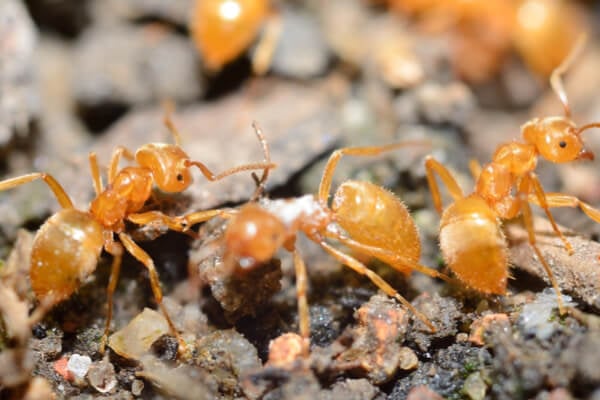How to Get Rid of Citronella Ants

The name “citronella ant” comes from the pungent lemony odor secreted by this species as a defense mechanism when threatened or crushed. Subterranean in nature, these ants are found all across the continental United States and are a common pest in most climates.
APPEARANCE AND BEHAVIOR
Citronella ant workers measure about ⅛” (3-4 mm) long and are bright yellow to orange-yellow in color. They can measure between 6 – 7 mm long (not including the wings) and are glossy brick-red or brownish-red in color. They have a single-segmented waist and no stinger. However, these ants will bite and spray pungent-smelling citronella onto anyone or thing they see as a threat.
Colony size typically ranges from a few hundred to several hundred individuals. Favored nesting sites include rotting logs and landscaping timbers (and the soil beneath), decaying stumps and the detritus-covered soil of fencerows and woodland settings. Swarming occurs from late summer through early autumn in natural settings. Workers forage honeydew from dandelion root aphids in the soil and hunt homopteran insects (aphids / plant lice, mealybugs, scale insects, etc.) on succulent plant parts above ground.
This species may freak out people who notice the fall-winter swarms in landscaping, basements, and crawl spaces. Citronella ants tend to import soil into sites in buildings chosen for nesting, including insulated sill plates and floor drain tiles. Similarly, nests may be located beneath slab foundations and in soil-floor crawl spaces. In such cases, the worker ants may be observed to forage indoors. The alates will aggregate around lights and windows.
CITRONELLA ANT CONTROL AND PREVENTION
Citronella ants that occasionally enter or swarm in buildings can be removed with a vacuum cleaner fitted with a hose attachment. Discourage the ants from foraging by controlling dandelions and other weeds, which serve as hosts for aphids. Make trees less attractive to foraging ants by periodically spraying trunks with a 1 or 2% detergent solution.
PROFESSIONAL PEST CONTROL

When you call us with concerns about a citronella ant infestation, a Schedule Now Plunkett’s technician will come quickly to assess the situation. One of the first steps they take is to apply a foundation perimeter treatment with residual liquid insecticide to discourage structural invasion. Spot treatments using residual liquid insecticide are made to nests located in the sill plate, crawl space, and any necessary areas of your landscaping.






